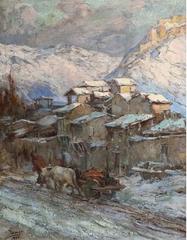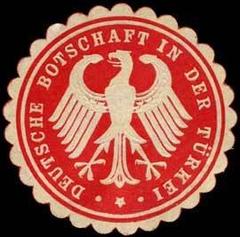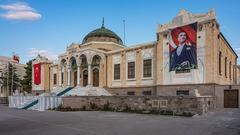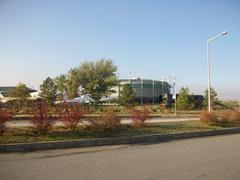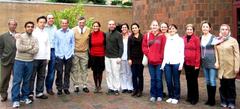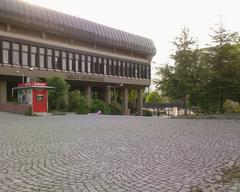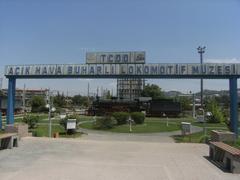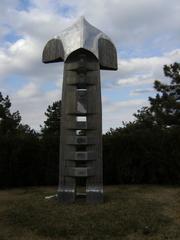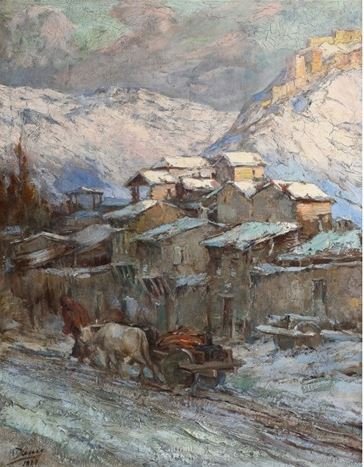
Ankara Castle Visiting Hours, Tickets, and Historic Sites Guide
Date: 14/06/2025
Introduction
Ankara Castle (Ankara Kalesi) is an enduring symbol of Turkey’s capital, standing atop a rocky hill and offering sweeping views of Ankara’s vibrant cityscape. With a history stretching back to at least the 8th century BCE, the castle’s stone walls, towers, and gates reflect the layered influences of the Phrygians, Galatians, Romans, Byzantines, Seljuks, and Ottomans. Today, it serves as a popular destination for history enthusiasts, families, photographers, and anyone eager to immerse themselves in Ankara’s rich cultural heritage. This comprehensive guide details Ankara Castle’s visiting hours, ticket information, architectural highlights, accessibility, and tips for making the most of your visit (Wikipedia; Supertravelr; Tourist Platform).
Historical Overview
Ancient Origins
The earliest fortifications of Ankara Castle are believed to date back to the 8th century BCE, likely built by the Phrygians. There is speculation of even earlier Hittite use of the site as a military outpost, though definitive archaeological evidence is lacking (Wikipedia; Supertravelr). Over time, the Galatians—Celtic settlers in Anatolia—rebuilt and reinforced the castle in the 3rd century BCE, using the hill’s strategic vantage point to their advantage.
Roman and Byzantine Periods
Under Roman rule, the castle was further expanded and fortified, notably during Emperor Caracalla’s reign in the 3rd century CE. The Persians inflicted significant damage during their invasions in the 3rd century, prompting further reconstructions. By the late 7th century, Byzantine rulers had strengthened the castle’s defenses, incorporating materials from Roman structures and constructing a new outer wall to accommodate Ankara’s growing urban population (Supertravelr).
Seljuk and Ottoman Influence
The Seljuks captured the castle in the 11th century, reinforcing its walls and adding characteristic Seljuk inscriptions and architectural details. The Ottomans later undertook significant repairs and adaptations, blending traditional Turkish motifs with the castle’s established form. Notably, in the 19th century, major restorations preserved the fortress as Ankara modernized (Supertravelr).
Architectural Features
Structure and Layout
Ankara Castle occupies roughly 43,000 square meters and is divided into the inner (İç Kale) and outer (Dış Kale) sections. The walls, built of stone and brick, are 2–3 meters thick and 8–10 meters high, and are reinforced with 14 towers and 42 turrets (Tourist Platform). The inner walls enclose a compact area with closely spaced towers, while the outer walls, constructed slightly later, provide additional protection.
Gates and Defensive Features
- Finger Gate (Parmak Kapısı): The main entrance, next to a 19th-century French clock tower, leads to a vibrant square near the Rahmi M. Koç Museum.
- White Fort (Ak Kale): This imposing Seljuk-era structure marks the highest point of the castle. While not open to the public, it is visible from the ramparts (Nomadic Niko).
- Other Defensive Elements: Additional gates, towers, and turrets are interspersed with historic marketplaces such as Atpazarı, Samanpazarı, and Koyunpazarı (Daily Sabah).
Materials and Architectural Styles
The castle’s walls and towers are an amalgam of Roman, Byzantine, Seljuk, and Ottoman masonry. Reused Roman marble blocks and column capitals (spolia) are embedded throughout, testifying to centuries of adaptive construction (Nomadic Niko). Seljuk decorative motifs and Ottoman wooden details further enrich the structure.
Residential and Civic Spaces
Within the castle are preserved Ottoman-era houses, many now functioning as boutique hotels, cafés, museums, or artisan shops. These homes, with their thick walls and distinctive bay windows, showcase Ankara’s architectural heritage and traditional way of life (Daily Sabah). Public squares and historic markets continue to serve as centers of local commerce and culture.
Panoramic Views and Cultural Life
The castle’s ramparts provide 360-degree views of Ankara, highlighting the contrast between ancient fortifications and modern cityscape (Guide to Europe). Artisan workshops, galleries, and occasional cultural events make the castle a lively hub for both locals and visitors.
Visiting Ankara Castle: Essential Information
Visiting Hours
- Standard Hours: Daily, 9:00 AM – 7:00 PM (April–October), and 9:00 AM – 5:00 PM (November–March).
- Note: Hours may vary seasonally; check the official Ankara tourism website or local listings before your visit.
Tickets and Entrance Fees
- General Admission: Free access to castle grounds.
- Special Exhibitions/Tours: Some guided tours or special exhibits may require a small fee.
Getting There
- Location: Ulus/Altındağ district, central Ankara.
- Transportation: Easily reached by public buses, taxis, or on foot from the city center. The approach involves uphill walking; wear comfortable shoes.
Accessibility
- Some areas are accessible to visitors with mobility challenges, but uneven surfaces and stairs are common due to the site’s historic nature. Visitors with disabilities should inquire about routes in advance.
Guided Tours
- Guided tours are available in multiple languages and can be arranged through local operators or visitor centers. Tours provide deeper historical and architectural context.
Facilities
- Cafés, artisan shops, and restrooms are available within or near the castle.
- Parking and public transport connections are nearby.
Travel Tips
- Best Times to Visit: Early morning or late afternoon for cooler temperatures, fewer crowds, and the best light for photography.
- Footwear: Comfortable shoes are essential due to cobblestone streets and steep paths.
- What to Bring: Water, sun protection, and a camera.
- Local Cuisine: Sample traditional Turkish snacks and tea in the castle’s cafes.
- Souvenirs: Browse for handmade crafts, jewelry, and ceramics in local shops.
Nearby Attractions
- Museum of Anatolian Civilizations: A renowned collection of ancient artifacts (Museum of Anatolian Civilizations).
- Rahmi M. Koç Museum: Industrial and transport history exhibits.
- Historic Marketplaces: Atpazarı, Samanpazarı, and Koyunpazarı.
- Kaleiçi Neighborhood: Explore restored Ottoman houses, artisan boutiques, and vibrant street life.
Cultural Events
- Ankara Castle is a venue for local festivals, art exhibitions, concerts, and national holiday celebrations throughout the year. Check local event calendars or the official website for current schedules.
Frequently Asked Questions (FAQs)
Q: What are Ankara Castle’s visiting hours?
A: Generally 9:00 AM – 7:00 PM (summer), 9:00 AM – 5:00 PM (winter), but confirm locally.
Q: Is there an entrance fee?
A: No, entry is free. Charges may apply for special exhibitions or guided tours.
Q: Can I visit with children?
A: Yes, but supervise children carefully due to steep paths and stairs.
Q: Are guided tours available?
A: Yes, in several languages. Book on-site or through tour agencies.
Q: Is the castle wheelchair accessible?
A: Some areas are accessible, but much of the site has uneven terrain and steps.
Visual Highlights
 Alt text: Panoramic view from Ankara Castle overlooking Ankara’s cityscape.
Alt text: Panoramic view from Ankara Castle overlooking Ankara’s cityscape.
 Alt text: Ancient stone walls and towers of Ankara Castle.
Alt text: Ancient stone walls and towers of Ankara Castle.
Conclusion
Ankara Castle is a living testament to the city’s layered history, offering visitors a captivating blend of ancient architecture, vibrant local culture, and breathtaking views. Whether you’re a history buff, photographer, or casual explorer, the castle provides an enriching and accessible experience. For the best visit, plan ahead, wear appropriate footwear, consider a guided tour, and don’t miss the artisan shops and panoramic photo opportunities.
Useful Links
- Ankara Castle on Wikipedia
- Official Ankara Tourism Website
- Museum of Anatolian Civilizations
- Supertravelr: A Brief History of Ankara Castle
- The Jewel of Central Anatolia: Ankara Castle
- Daily Sabah: Ankara Castle
- Nomadic Niko: Ankara Castle
- Guide to Europe: Ankara Castle Attractions
Call to Action
Ready to explore Ankara Castle? Download the Audiala app for personalized travel guides, event updates, and offline maps. For more Turkish heritage insights and travel inspiration, follow us on social media and check out our related articles on Ankara’s historical treasures.
